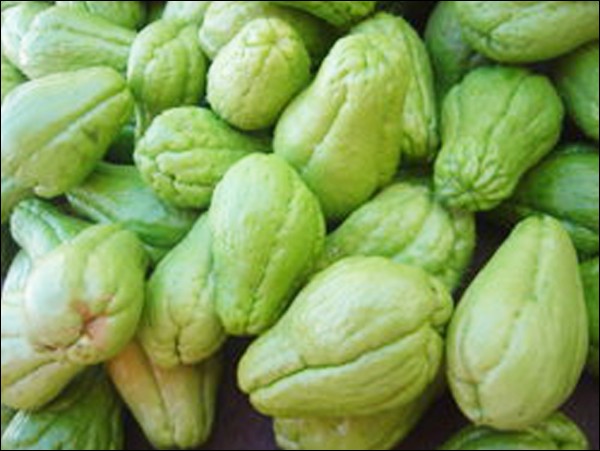Pork & mirliton pie
Six good wedges of pie.
As Carl and Roberta Bridenbaugh have observed, seventeenth and eighteenth century English emigrants to the Caribbean tried hard to cling to their traditional foodways despite the alien climate and its wealth of strange produce. Sanity or at least flexibility eventually would prevail, out of necessity as much as anything else, but adaptation as opposed to creativity or adventurism became the preferred option for most Caribbeans of British stock down the years. We find the consequent hybrid preparations appealing, and this pie is one of the best. It is intended to resemble a Devonshire recipe for a pie of pigeon with apples; the filling of pork and mirliton, seasoned with lime, is no bleak imitation but rather something superb in its own right.
 -4 mirlitons, peeled, cored and cut into uniform cubes
-4 mirlitons, peeled, cored and cut into uniform cubes
-4 cloves
-juice of a lime
-1 Tablespoon unsalted butter
-salt
-about 2 ½ cups thinly sliced onions
-another Tablespoon unsalted butter
-1 Tablespoon flour
-about 1 cup pork or chicken stock
-pie pastry (see the Notes)
-3 thin slices of ham or Irish bacon
-1 lb thinly sliced pork shoulder
-a sprinkling of allspice
-a sprinkling of ground bay
-some minced fresh chili
-a beaten egg
- Put the mirliton cubes and cloves in a pot with barely enough salted water to cover and boil them briskly just until they are barely fork tender.
- Shock the mirliton under cold water to preventthem from cooking further, throw away the cloves and toss the mirliton with the lime juice.
- Melt the first Tablespoon of butter over medium heat, coat the onions with the butter, salt them and cook the onions until they soften but do not brown.
- Remove the onions from their pan and melt the other Tablespoon of butter. Whisk the flour into the butter to make a white roux, then slowly pour the stock into the pan, adding more each time the liquid in the pan returns to a boil. Cook the gravy until it thickens.
Preheat the oven to 375°. - Line a 9 inch pie pan with half of the pastry and cover it with the ham or bacon.
- Add a layer of pork to the pie, sprinkle the meat with traces of allspice and bay along with generous seasonings of salt and pepper.
- Top the pork with a third of the onion and the chilies.
- Top the onion with half of the mirliton, then repeat Steps 6 and 7 except for the chilies.
- Top the mirliton with the rest of the onion and roll out the topcrust and crimp it to the bottom crust with a fork.
- Vent the top crust, decorate it with scraps of pastry shaped like pineapples or palm trees and paint the pastry with the egg.
- Bake the pie until the crust turns deep gold, usually in a little over an hour.
Notes:
- Alternative terms for mirliton include chayote, cho cho and corstorphine. It looks like a pale green lumpy apple and is a relative of the cucumber.
- The genesis of this recipe appears in Caroline Sullivan’s collection of nineteenth century recipes from Jamaica, collected and published by John Kenneth McKenzie Pringle as, appropriately enough, A Collection of 19th Century Jamaican Cookery and Herbal Recipes in 1893; the Editor’s copy is a 1990 facsimile of the expanded second edition of 1897. It is a charming text and production values are superb.
- The Sullivan recipe itself is succinct; it offers just enough guidance. The only listed ingredients are ‘One lb. of fresh pork, two onions, four large cho-chos, a few cloves and one lime.’ The instructions are:
“Boil the cho-chos with a few cloves till tender and take away the pith part, chop into dice, and squeeze the juice of the lime over it. Then put in a pie dish previously lined with pastry, a layer of sliced pork, then a layer of the chopped cho-chos and chopped onions till the dish is full. Cover with pastry first filling in with some good gravy and bake for from one hour to one hour and a half.”
The Editor added the base of ham to keep the crust from going soggy and precooked the onion because the consistency of the pie with raw onion was a little runny. The added chilies are there for the obvious reason.
- If you have a reserve of ‘good gravy,’ by all means use it.
Recipes for piecrust pastry appear both in our recipes and in our archive.
- The original Devonshire pie is good too, and may be made with pork as well as pigeon. Take this recipe but replace the mirliton and lime with peeled sliced apples--no need to cook them or the onions--omit the chilies and proceed apace. The allspice and bay are up to you.

